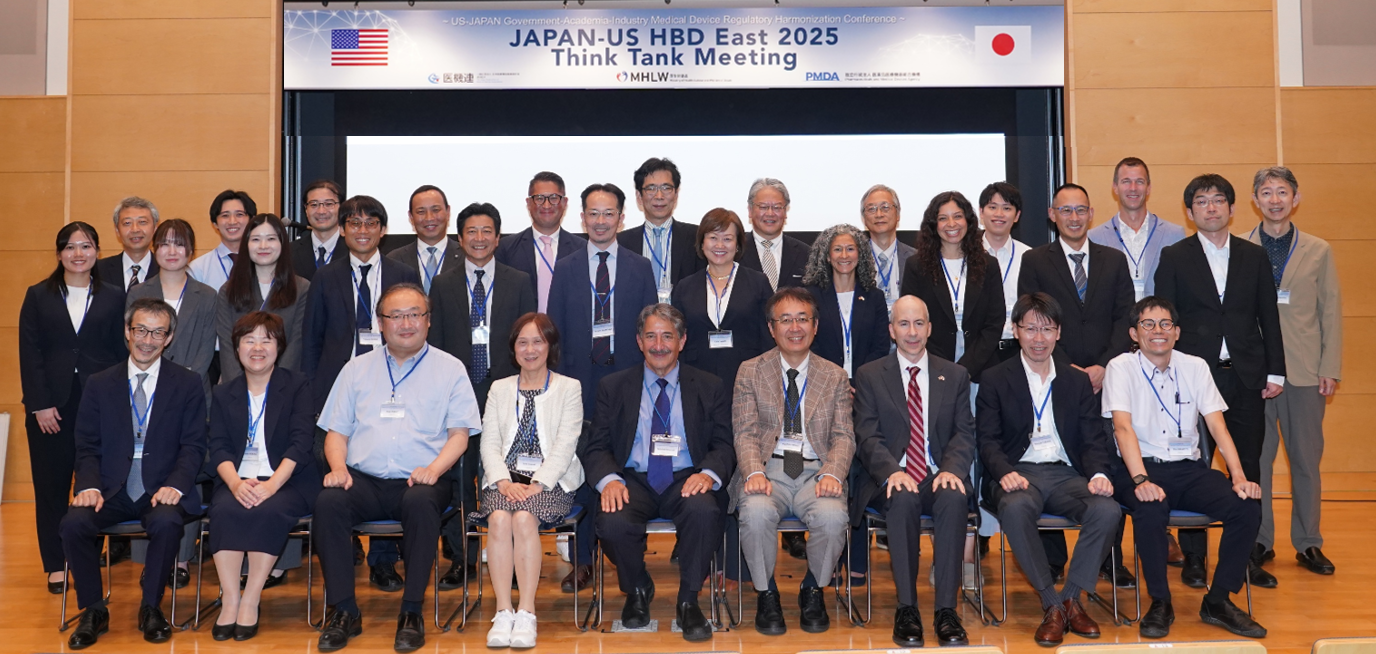Through Japan-US Medical Device Harmonization by Doing (HBD)1, the U.S. FDA2, MHLW/PMDA, academia, and industry developed internationally agreed upon standards for global clinical trials related to cardiovascular devices, and addressed regulatory barriers that may delay timely medical device approvals in both countries.
Held in conjunction with the IMDRF, the HBD East 2025 Think Tank Meeting welcomed broad participation from government authorities, academia, and the medical device industry across multiple countries, not limited to the United States and Japan.
In addition to reporting on HBD activities, the meeting addressed topics of current interest, including the promotion of pediatric medical-device development, the advancement of software as medical devices (SaMD), the utilization of Real-World Evidence (RWE), and industry–government–academic collaboration to facilitate efficient medical-device development. At the conclusion of each session, a panel discussion was convened to examine challenges in medical-device development from multiple perspectives and to consider potential solutions.
Ref)
1) HBD Brochure (in English) [433KB]
2) U.S.-Japan Regulatory Collaboration | FDA
Host
Ministry of Health, Labour and Welfare (MHLW)
Pharmaceuticals and Medical Devices Agency (PMDA)
The Japan Federation of Medical Device Associations (JFMDA)
Date
Wednesday, September 17, 2025
9:30 a.m. to 6:00 p.m. JST(UST+9)
Venue
Sapporo Convention Center (Small Hall 2F) ,
1-1-1 Higashi-Sapporo 6-jo, Shiroishi-ku, Sapporo, Hokkaido, 003-0006, Japan
Acsess, please click here.
Speakers

Outcome
Outcome Statement[262.77KB]
Program
For more information on HBD East 2025 Think Tank Meeting, please click here.[243KB]
| 9:30 |
Session A
Welome |
| 9:55 |
Session B
Keynote Lecture |
| B-1 |
Japanese initiative to promote medical device development[1.75MB] |
| B-2 |
HBD history and global lessons learned[11.09MB] |
| 10:35 |
Session C
Update on HBD activities |
| C-1 |
Update on HBD activities (2020–2025)[1.27MB] |
| 11:00 |
Session D
HBD activities to advance pediatric device development and access |
| D-1 |
HBD for Children - Achievements and future directions[1.45MB] |
| D-2 |
Considerations in Japanese academia in advancing pediatric medical device development, Insight from Japan’s Agency for Medical Research and Development[1.86MB] |
| D-3 |
Japanese research projects and regulatory initiatives to promote medical device access for intractable/rare diseases |
| D-4 |
What else is needed to advance pediatric medical device development? Industry perspective[299.25KB] |
| D-5 |
Panel discussion, Breaking barriers, Driving cross-sector collaboration and increased global access |
| 13:10 |
Session E
HBD activities to advance smart development of SaMD |
| E-1 |
Regulatory updates Japan[1.69MB] |
| E-2 |
Regulatory updates US[2.90MB] |
| E-3 |
Initiatives to support the expansion of Japanese medical devices into overseas markets, Japanese ministry perspective[1.76MB] |
| E-4 |
Considerations in international development of digital health technologies[1.70MB] |
| E-5 |
Panel discussion, Global strategies to accelerate SaMD development, perspectives from industry, academia, and government |
| 14:25 |
Session F
Challenges and solutions when building multi-national registries |
| F-1 |
The current situation and future direction of utilization of real-world clinical evidence for regulatory decision-making[450.04KB] |
| F-2 |
Experiences with regulatory use of registry data, Industry perspective |
| F-3 |
Consideration and future opportunities identified through the utilization of real-world evidence[872KB] |
| F-4 |
Deciding whether a registry should go global, Japanese academic perspective[2.47MB] |
| F-5 |
Challenges and solutions when building multi-national registries. |
| 15:50 |
Session G
Shaping forward-looking collaboration among stakeholders for more efficient global medical device development |
| G-1 |
Addressing key bottlenecks in global medical device development, challenges and strategic solutions[638KB] |
| G-2 |
Lessons from success, Rethinking collaboration among stakeholders in medical device innovation[296KB] |
| G-3 |
Initiatives to accelerate medical device access, US regulatory perspective[1.29MB] |
| G-4 |
Initiatives to accelerate medical device access, Singapore regulatory perspective[1.19MB] |
| G-5 |
Panel discussion, Envisioning global collaboration in medical device development - a 10-year outlook from industry, academia, and government |
| 17:10 |
Session H
Closing remarks |

